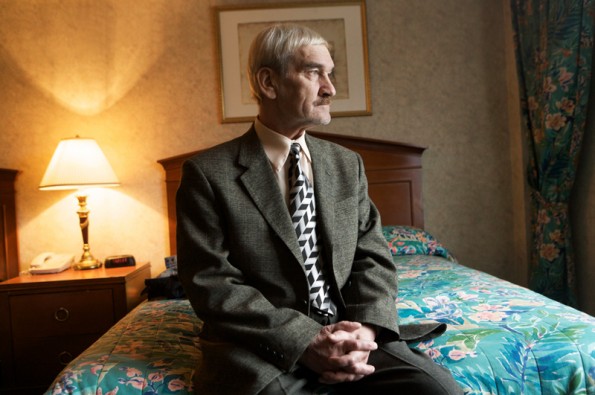The Man Who Saved the World
If Stanislav Petrov wasn’t a real person, an author of paperback Cold War spy thrillers could have invented him. Gruff and possessing a heavy drinking streak, Petrov may look like a classic Soviet villain, but in director’s Peter Anthony’s quasi-documentary The Man Who Saved The World, he becomes a peace-maker who has great pressure (and opportunity) thrust upon him. “I’m not a hero,” he insists repeatedly. “I was just in the right place at the right time.”
The time was a few hours on September 26th, 1983. A lieutenant colonel in the Soviet Air Forces, he was stationed in a bunker outside of Moscow when computers detected five American nuclear missiles headed for the Soviet Union. Disregarding protocol, Petrov opted not to retaliate and instead he waited for visual confirmation. The nuclear missiles were only a phantom attack, products of an undiscoverable glitch in the system. Gratefully, a nuclear holocaust was avoided. Now, Petrov travels the world, accepts prizes and meets American movie stars (Petrov loves Kevin Costner). And the world rests in safety.
Yet, Anthony’s film is an ambitious, if fatally flawed attempt, to tell a different story. Not merely complacent to be a drama, The Man Who Saved The World is equally part road-trip movie, family soap opera and political polemic. The end result is a rather interesting, instructive mess.
The Man Who Saved the World begins with an epigraph from Mark 8:36: “For what shall it profit a man if he shall gain the whole world, and lose his own soul.” In Petrov, Anthony has found a subject full of worldly contradictions. Even as Petrov saved millions of lives, he couldn’t rescue his dying wife. He shout at this translator,Galina Kalinina, that he won’t discuss his personal life, yet here he is starring in a documentary. Also estranged from his mother, Petrov is clearly lonely, making him worthy of our sympathy even as he barks and berates Kalinina and others who frustrate him.
So why doesn’t The Man Who Saved the World work better? The problem starts with the decision to reconstruct the events of 1983. The film features numerous flashbacks to Petrov’s heroics and subsequent dismissal from the Soviet Air Forces at the hands of a jealous superior. Russian actor Sergey Shynrov plays Petrov admirably in these whirlwind (and entertaining) reenactments of the Soviet panic and disarray. On their own, these scenes function well, but they weaken the purpose and resolve of the film. Petrov’s actions are most interesting in order that Petrov can reflect on them and struggle with how his perception of the events have changed and how the events have changed him. In other words, we need Petrov’s past to watch his character develop. By staging these reconstructions, Anthony not only distracts the audience; he creates an unbridgeable gulf between the viewer and Petrov. If Petrov can only reflect on 1983 as a distant memory, why should we see it on equal terms, cut and dispersed, with the modern day? By reconstructing the action of the Cold War (and placing these scenes in the middle of the film), Anthony turns The Man Who Saved The World into a literal historical fantasy, in which the nature of time, one of the most powerful forces to act on life, is lost.
The political message of Petrov’s story is decidedly pro-nuclear disarmament and anti-war. “As long as both sides keep their arsenals, the danger of nuclear war cannot be excluded,” Petrov declares. Petrov warns of the ever-present possibility of a nuclear attack and of weapons falling into the hands of terrorists. Stock footage of 9/11 and missile launches hammer home the threat. Anthony seems willing to allow Petrov to basically speak his mind on political issues. Occasionally this leads to statements (“It’s time to forget about the Cold War completely”) that seems woefully ignorant of the Russian government’s military actions in Ukraine and the violent strain of anti-Americanism promoted by the Kremlin.
Along with its message of disarmament, The Man Who Saves The World has a few other strengths. The productions values are solid, a nice soundtrack compliments the mood of scenes. Anthony films some moments that are also quite amusing, including a scene with Petrov at a gun range in America shooting up a Osama Bin Laden target. Visiting a movie set, Petrov doesn’t recognize Matt Damon, mistaking him for Robert De Niro’s son. Thankfully, Damon just laughs it off.
Yet, again and again, I found The Man Who Saved The World hindered not by its execution but by its very genesis. A Financial Times interview from May unearthed that Petrov’s road trip to meet Costner and his climactic reunion with his mother “wouldn’t have happened without [Anthony’s] urging, and yet this involvement goes unacknowledged.” If Anthony is orchestrating the film, the viewer deserves to know. The entire legitimacy and journalistic value of the film is at risk.
But just as importantly, Anthony’s invisibility is the final artistic failure of The Man Who Saved The World. What kind of man befriends a washed-up Soviet hero, and then takes him to meet a movie star and his estranged mother? How did the relationship between Petrov and Anthony change? Did Anthony compromise any of his own cinematic vision because of his closeness, his personal relationship with Petrov? These are among the most interesting questions that The Man Who Saved The World causes us to ask, but we can only grasp for the thinnest of answers. Ultimately, Anthony’s movie fails to satisfy our search for understanding; it will take another film to measure up to the extraordinary life of Stanislav Petrov.
The Man Who Saved the World will be in U.S. Theaters beginning September 18th.

